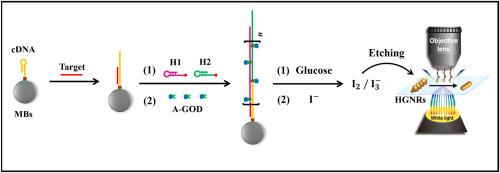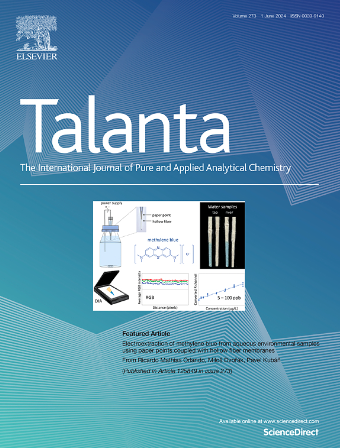螺旋金纳米棒作为暗场光散射光学探针的杂交链式反应和磁珠辅助高灵敏度检测microRNA-21。
IF 6.1
1区 化学
Q1 CHEMISTRY, ANALYTICAL
引用次数: 0
摘要
microRNA-21 (miRNA-21)作为一种很有前景的癌症生物标志物,受到了人们的广泛关注。然而,由于miRNA-21的丰度较低,对其检测灵敏度要求很高。本研究以螺旋金纳米棒(HGNRs)为暗场光散射探针,基于杂交链反应(HCR)和磁珠(mb)辅助级联信号放大策略,建立了高灵敏度的miRNA-21检测平台。靶miRNA-21触发三碘化物(I3-)介导的hgnr蚀刻,导致hgnr散射强度降低。与普通金纳米棒相比,粗糙表面的凸出螺旋结构赋予HGNRs更大的比表面积和更高的反应性,使得HGNRs具有更高的灵敏度,线性范围为0.1-3 pmol/L,检出限低至61.33 fmol/L,实现了对癌症患者血清样品中miRNA-21的检测。此外,该策略具有显著的特异性和较高的准确性,能够区分错配序列,并提供与聚合酶链反应相似的结果,为癌症的早期诊断提供了新的思路。本文章由计算机程序翻译,如有差异,请以英文原文为准。

Hybridization chain reaction and magnetic beads-assisted highly sensitive detection of microRNA-21 with helical gold nanorods as dark-filed light scattering optical probe
As a promising cancer biomarker, microRNA-21 (miRNA-21) has attracted great attention. However, the assay sensitivity of miRNA-21 is highly demanded due to its low abundance. In this work, a highly sensitive sensing platform for miRNA-21 detection was developed based on hybridization chain reaction (HCR) and magnetic beads (MBs)-assisted cascade signal amplification strategy with helical gold nanorods (HGNRs) as dark-field light scattering probes. The target miRNA-21 triggered triiodide (I3−)-mediated etching of HGNRs, leading to the decrease in scattering intensity of HGNRs. Compared with the common gold nanorods, the protuberant helical structure on the rough surface endowed HGNRs with larger specific surface area and higher reactivity, resulting in a higher sensitivity with a linear range of 0.1–3 pmol/L and a limit of detection as low as 61.33 fmol/L, which realized the detection of miRNA-21 in serum samples from cancer patients. Moreover, the proposed strategy offered the remarkable specificity and high accuracy, which was capable of distinguishing mismatch sequences and offering the similar result obtained from polymerase chain reaction, supplying a new idea for early diagnosis of cancers.
求助全文
通过发布文献求助,成功后即可免费获取论文全文。
去求助
来源期刊

Talanta
化学-分析化学
CiteScore
12.30
自引率
4.90%
发文量
861
审稿时长
29 days
期刊介绍:
Talanta provides a forum for the publication of original research papers, short communications, and critical reviews in all branches of pure and applied analytical chemistry. Papers are evaluated based on established guidelines, including the fundamental nature of the study, scientific novelty, substantial improvement or advantage over existing technology or methods, and demonstrated analytical applicability. Original research papers on fundamental studies, and on novel sensor and instrumentation developments, are encouraged. Novel or improved applications in areas such as clinical and biological chemistry, environmental analysis, geochemistry, materials science and engineering, and analytical platforms for omics development are welcome.
Analytical performance of methods should be determined, including interference and matrix effects, and methods should be validated by comparison with a standard method, or analysis of a certified reference material. Simple spiking recoveries may not be sufficient. The developed method should especially comprise information on selectivity, sensitivity, detection limits, accuracy, and reliability. However, applying official validation or robustness studies to a routine method or technique does not necessarily constitute novelty. Proper statistical treatment of the data should be provided. Relevant literature should be cited, including related publications by the authors, and authors should discuss how their proposed methodology compares with previously reported methods.
 求助内容:
求助内容: 应助结果提醒方式:
应助结果提醒方式:


